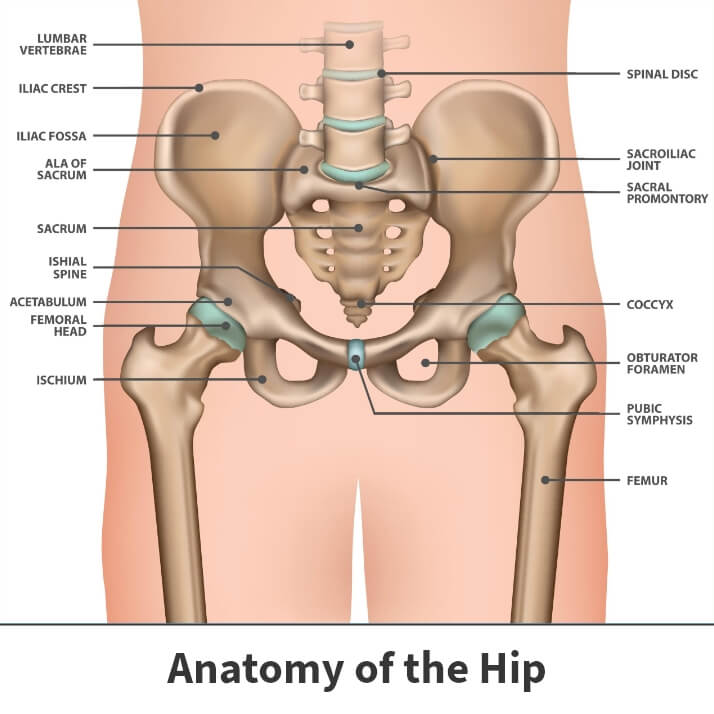Hip fractures
A hip fracture is an injury that typically only affects people over the age of 65. They occur when the bone in the hip joint breaks or fractures. This injury is usually caused by either a hard fall or from having extremely weak bones. Most people who suffer from a hip fracture need surgery to fully repair the hip. Most people make a full recovery and can regain their independence and quality of life.
Anatomy

The hip is a ball and socket joint. The socket is formed by the large pelvis bone (acetabulum) and the ball on the upper end of the thighbone (femoral head). A slippery tissue known as the articular cartilage covers the surface of joint, creating a smooth surface that allows the bones to glide easily across each other.
The large pelvis bone is ringed by strong fibrocartilage known as the labrum, which forms a lining around the socket.
Additionally, the whole joint is surrounded by bands of tissue (ligaments), forming a capsule that holds the joint together. The undersurface of the capsule is lined by a thin membrane (synovium) which produces synovial fluid that lubricates the hip joint.
About
A hip fracture is a break in the upper section of the thighbone, just below the hip joint. Hip fractures are serious injuries that typically occur to people over the age of 65 but can potentially happen to anyone at any age.
Hard falls and weak bones are the leading causes of hip fractures. But medical conditions such as osteoporosis, cancer, or stress injuries can weaken the bone and make the hip more prone to breaking. In severe cases, a hip fracture can occur from just standing on the leg and twisting the body.
There are three different types of hip fractures; an intracapsular fracture, an intertrochanteric fracture, and a subtrochanteric fracture. The type of fracture is determined by the location of the fracture. In more severe cases, people can get multiple breaks in one or more of these areas.
- Intracapsular fracture – occurs at the neck and head of the thighbone
- Intertrochanteric fracture – between the neck of the thighbone and the lesser trochanter, which is the attachment point for one of the major muscles of the hip
- Subtrochanteric fracture – when the hip fracture is below the lesser trochanter
Hip fractures limit mobility and threaten independence, as this injury usually results in surgery, hospitalization, and extended rehabilitation. Unfortunately, most people who have suffered a hip fracture need extra help afterward. This extra help can include anything from a family member or a home health professional to admittance to a nursing home.

Symptoms
Pain and discomfort are the main symptoms of hip fractures. You will experience pain over the outer upper thigh or in the groin. Also, you will experience significant discomfort anytime you try to move the hip or put weight on the injured leg.
If another disease caused the hip fracture, you would have felt an aching pain in the groin or thigh area in the days and weeks leading up to the injury.
Diagnosis
Your Florida Orthopaedic Institute physician will first take a look at your symptoms, overall health, and medical history. After the examination, they will order some tests to confirm your diagnosis. These tests are:
- X-ray – An X-ray produces images of the dense structures within the body, such as bone. If you suffered a full hip fracture, this test will produce an image of it.
- MRI – MRI scans do a great job of generating images of incomplete hip fractures. An incomplete hip fracture is when the bone doesn’t fully break; it just partially breaks. If the X-ray does not pick up the fracture, the MRI will.
- CT – Computed tomography scan.
Treatment
Surgery is the primary way of treating hip fractures. If you are too ill to undergo surgery or were not walking before the injury, then you may be given nonsurgical treatments. If not, then you will have to undergo surgery.
Nonsurgical treatments
Nonsurgical treatment is typically only recommended to people who are too ill to undergo any form of anesthesia or people who were unable to walk before their injury. Nonsurgical treatments may also be recommended to people with hip fractures that did not result in the bone moving. These fractures are known as stable fractures. The treatment plan for these people is to completely avoid putting any pressure whatsoever on the hip, which typically involves bed rest until the fracture begins to heal.
If patients are confined to bed rest as part of the management for these fractures, they will need to be closely monitored for complications that can occur from prolonged immobilization. These include infections, bedsores, pneumonia, and blood clots. Additionally, if you had a stable fracture, you will also have to be monitored because it is very easy for your fracture to become unstable. Your physician will be taking frequent X-rays to make sure this does not happen.
Surgical treatments
There are several different procedures available and are used depending on the type of fracture you have.
For all the different types of fractures, your surgeon may decide either to fix the fracture with individual screws (percutaneous pinning) or a single larger screw that slides within the barrel of a plate. In young patients, the goal of the surgery is to reduce, or realign, the fracture through a larger incision. The fracture is held together with either individual screws or with the larger compression hip screw. In cases where the blood supply to the top of the thighbone, known as the femoral head, is damaged, that entire part of the femur may be replaced. The only difference between the different types of fractures is the types of screws that are used.
You may be discharged from the hospital and either go home or to a rehabilitation facility if necessary to assist you in regaining your ability to walk.
Recovery
People who have suffered a hip fracture and have undergone surgery will have to go through extensive rehabilitation to learn how to walk again. Most patients will regain much, if not all, of the mobility and independence they had before the injury.
Prevention
As we age, our bones get weaker, which increases our chances of suffering a hip fracture. Here are some things you can do to improve your bone strength and lessen your chances of a hip fracture:
- Make healthy lifestyle choices – Maintaining a healthy weight and eating a diet rich in calcium and Vitamin D will strengthen your bones. Do not smoke and limit your alcohol intake.
- Consider bone-boosting medications – Many medications can slow bone loss and increase bone strength.
- Understand your risk for fracture – Depending on your genetics and overall medical health, you may have a higher chance of getting a hip fracture.
- Understand your risk for bone loss – Genetics play a role in bone health, and some people have genetically determined high rates of bone loss after menopause or with aging.
Videos
Related specialties
- Anterior Hip Replacement
- Avascular Necrosis (Osteonecrosis)
- Groin Strains & Pulls
- Hamstring Injuries
- Hip Arthroplasty
- Hip Arthroscopy
- Hip Dislocation
- Hip Flexor Strains
- Hip Hemiarthroplasty
- Hip Impingement Labral Tears
- Hip Muscle Strains
- Hip Pointers & Trochanteric Bursitis
- Iliopsoas Tenotomy
- Labral Tears of the Hip (Acetabular Labrum Tears)
- Osteoarthritis of the Hip
- Osteoporosis
- Pelvic Ring Fractures
- Piriformis Syndrome
- Sports Hernias (Athletic Pubalgia)
- Thigh Fractures
- Thigh Muscle Strains
